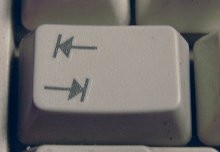Tab key
The tab key ↹ , abbreviated Tab , (sometimes "Tab key") is a key on a keyboard (for typewriters and computers , including on- screen keyboards ).
The following article describes how the Tab key works on computers. A description of the tab and the decimal tab can be found in the article Lever typewriter .
Origin of the term
The word “tabulator” refers to the so-called function of dividing texts or numbers into columns in a meaningful way and aligning them with one another (e.g. tables, invoices, lists). A distinction is made between "aligned left", "aligned right", "centered" and "decimal tab".
description
On a PC keyboard with a German / Austrian assignment, the tab key is usually ↹labeled with two horizontally superimposed arrows, each with an end line ( ), and with a Swiss assignment also with "Tab". On an Apple keyboard , the key is represented by an icon with a right-pointing arrow and a dash ( ⇥).
It is on standard keyboards top left, above the Caps Lock key ( ⇩) and next to the Q key ( Q).
| Esc | F1 | F2 | F3 | F4 | F5 | F6 | F7 | F8 | F9 | F10 | F11 | F12 |
Print S-Dep |
roll |
pause break |
Numeric keypad : | ||||||||

|
Insert | Pos1 | Image ↑ | Num | / | * | - | |||||||||||||||||
| Dist | The End | Image ↓ | 7th | 8th | 9 | + | ||||||||||||||||||
| 4th | 5 | 6th | ||||||||||||||||||||||
| ↑ | 1 | 2 | 3 | Enter | ||||||||||||||||||||
| ← | ↓ | → | 0 | , | ||||||||||||||||||||
function
Command line: On the command line , the tab key is used to complete the command line .
Graphic shells: In many desktop environments and window managers , a key combination such as Alt+ can bring↹ a window in the background to the foreground ( focus ). As a rule, you can use the tab key (for example in dialog windows ) to jump from one control element to the next. Elements such as B. Links or form fields, if necessary, can be selected with the tab key. You then get the input focus and can then be used with the return key or the enter key. A programmer can determine the order. Hold down the Shift key ( ⇧) to reverse the order.
Text processing: Use the Tab key can be the cursor ( English cursor ) move forward by a predetermined distance. This tab function is available in most word processors. In many programs that are used for text processing, a tab character ( ASCII code 9) is inserted directly into the text. Other programs use their own character codes for this or replace the spacing with spaces , which is only useful for non-proportional fonts . In a more advanced variant, you are not limited to the same distances between the jumpable positions, but you can choose them freely, e.g. B. to achieve certain form designs. These functionalities were already available at least in the better typewriter models. If you hold down the Shift key ( ⇧), it usually causes a tabulator step backwards. The position at which the cursor stops when you press the tab key is determined by the tab stop or tab stop. This ensures that the text is left-justified, right-justified or centered at the position.
character
The character ↹ generally used to represent the tab key has the Unicode code point U + 21B9 , the HTML entities ↹(hexadecimal) and ↹(decimal) and the URL escape code %E2%86%B9.
The character ⇥ used in particular by Apple to represent the tab key has the Unicode code point U + 21E5 , the HTML entities ⇥(hexadecimal) and ⇥(decimal) and the URL escape code %E2%87%A5.
Individual evidence
- ↑ ↹ - leftwards arrow to bar over rightwards arrow to bar (U + 21B9) @ Graphemica. In: graphemica.com. Accessed April 27, 2019 .
- ↑ ⇥ - rightwards arrow to bar (U + 21E5) @ Graphemica. In: graphemica.com. Accessed April 27, 2019 .
